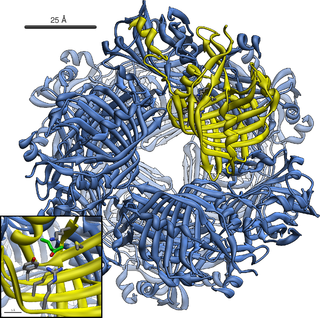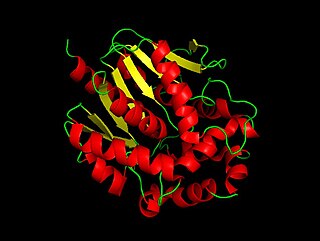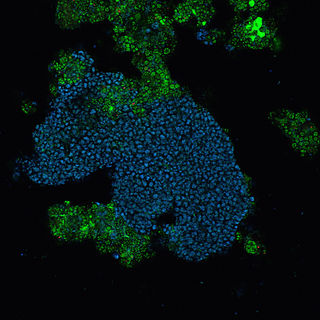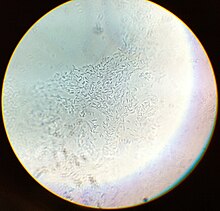Fusel alcohols or fuselol, also sometimes called fusel oils in Europe, are mixtures of several higher alcohols produced as a by-product of alcoholic fermentation. The word Fusel is German for "bad liquor".

1-Butanol, also known as butan-1-ol or n-butanol, is a primary alcohol with the chemical formula C4H9OH and a linear structure. Isomers of 1-butanol are isobutanol, butan-2-ol and tert-butanol. The unmodified term butanol usually refers to the straight chain isomer.
Cellulosomes are multi-enzyme extracellular complexes. Cellulosomes are associated with the cell surface and mediate cell attachment to insoluble substrates and degrade them to soluble products which are then absorbed. Cellulosome complexes are intricate, multi-enzyme machines, produced by many cellulolytic microorganisms. They are produced by microorganisms for efficient degradation of plant cell wall polysaccharides, notably cellulose, the most abundant organic polymer on Earth. The multiple subunits of cellulosomes are composed of numerous functional domains that interact with each other and with the cellulosic substrate. One of these subunits, a large glycoprotein "scaffoldin", is a distinctive class of non-catalytic scaffolding polypeptides. The scaffoldin subunit selectively integrates the various cellulases and xylanase subunits into the cohesive complex, by combining its cohesin domains with a typical dockerin domain present on each of the subunit enzymes. The scaffoldin of some cellulosomes, an example being that of Clostridium thermocellum, contains a carbohydrate-binding module that adheres cellulose to the cellulosomal complex.

Butanol may be used as a fuel in an internal combustion engine. It is more similar to gasoline than it is to ethanol. A C4-hydrocarbon, butanol is a drop-in fuel and thus works in vehicles designed for use with gasoline without modification. Both n-butanol and isobutanol have been studied as possible fuels. Both can be produced from biomass (as "biobutanol" ) as well as from fossil fuels (as "petrobutanol"). The chemical properties depend on the isomer (n-butanol or isobutanol), not on the production method.

Acetoacetate decarboxylase is an enzyme involved in both the ketone body production pathway in humans and other mammals, and solventogenesis in bacteria. Acetoacetate decarboxylase plays a key role in solvent production by catalyzing the decarboxylation of acetoacetate, yielding acetone and carbon dioxide.
"Pseudomonas helianthi" is a Gram-negative plant pathogenic bacterium that infects a variety of plants. It was once considered a pathovar of Pseudomonas syringae, but following DNA-relatedness studies, it was recognized as a separate species and P. syringae pv. tagetis was incorporated into it, as well. Since no official name has yet been given, it is referred to by the epithet 'Pseudomonas helianthi' .

Acetone–butanol–ethanol (ABE) fermentation, also known as the Weizmann process, is a process that uses bacterial fermentation to produce acetone, n-butanol, and ethanol from carbohydrates such as starch and glucose. It was developed by chemist Chaim Weizmann and was the primary process used to produce acetone, which was needed to make cordite, a substance essential for the British war industry during World War I.

In enzymology, a haloalkane dehalogenase (EC 3.8.1.5) is an enzyme that catalyzes the chemical reaction

Clostridium beijerinckii is a gram positive, rod shaped, motile bacterium of the genus Clostridium. It has been isolated from feces and soil. Produces oval to subterminal spores. it is named after Martinus Beijerinck who is a Dutch bacteriologist.

Raoultella planticola is a Gram-negative bacterium of the genus Raoultella. R. planticola is quite similar in appearance to Klebsiella pneumoniae and must be identified based on growth habits or DNA analysis. A number of strains have been identified. R. planticola has been determined to have complicated at least one case of severe pancreatitis.

Candidatus Accumulibacter phosphatis (CAP) is an unclassified type of Betaproteobacteria that is a common bacterial community member of sewage treatment and wastewater treatment plants performing enhanced biological phosphorus removal (EBPR) and is a polyphosphate-accumulating organism. The role of CAP in EBPR was elucidated using culture-independent approaches such as 16S rRNA clone banks that showed the Betaproteobacteria dominated lab-scale EBPR reactors. Further work using clone banks and fluorescence in situ hybridization identified a group of bacteria, closely related to Rhodocyclus as the dominant member of lab-scale communities.
Dehalogenimonas lykanthroporepellens is an anaerobic, Gram-negative bacteria in the phylum Chloroflexota isolated from a Superfund site in Baton Rouge, Louisiana. It is useful in bioremediation for its ability to reductively dehalogenate chlorinated alkanes.
Clostridium autoethanogenum is an anaerobic bacterium that produces ethanol from carbon monoxide, in so-called syngas fermentation, being one of the few known microorganisms to do so. It is gram-positive, spore-forming, rod-like, motile, and was first isolated from rabbit feces. Its type strain is strain JA1-1. Its genome has been sequenced and the genes required for utilising carbon monoxide as a sole carbon and energy source have been determined.
Clostridium saccharoperbutylacetonicum is an indole and notably butanol-producing bacterium, with the type strain N1-4 (HMT). Its genome has been sequenced.
Clostridium saccharobutylicum is an indole and notably acetone, butanol and ethanol-producing bacterium, with type strain DSM 13864T. Its genome has been sequenced.
Granadaene is the trivial name of a non-isoprenoid polyene that constitutes the red pigment characteristic of Streptococcus agalactiae.
Clostridium pasteurianum is a bacterium discovered in 1890 by the Russian microbiologist Sergei Winogradsky. It was the first free living (non-symbiotic) micro-organism discovered that could fix free nitrogen from the air.
Desulfovibrio desulfuricans is a Gram-negative sulfate-reducing bacteria. It is generally found in soil, water, and the stools of animals, although in rare cases it has been found to cause infection in humans. It is particularly noted for its ability to produce methyl mercury. The reductive glycine pathway, a seventh route for organisms to capture CO2, was discovered in this species. Since these bacteria are killed by exposure to atmospheric oxygen, the environmental niches most frequently occupied by these bacteria are anaerobic. Desulfovibrio desulfuricans 27774 was reported to produce gene transfer agents.

Solventogenesis is the biochemical production of solvents by Clostridium species. It is the second phase of ABE fermentation.









